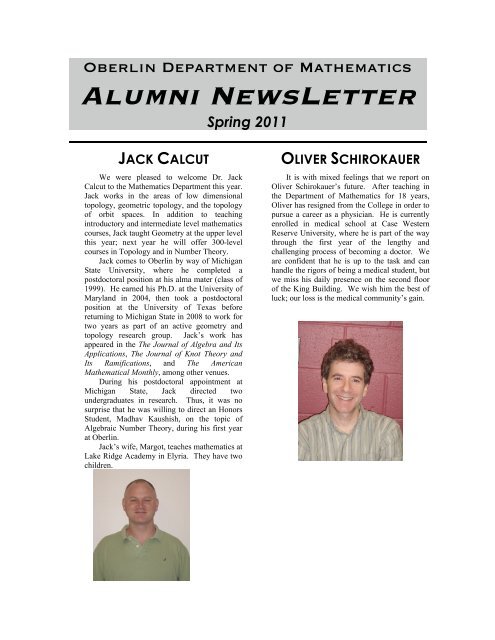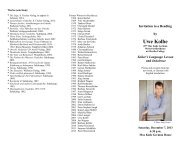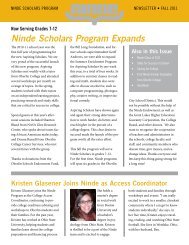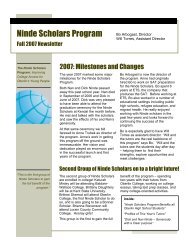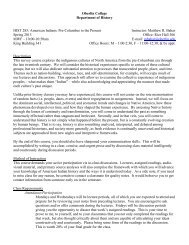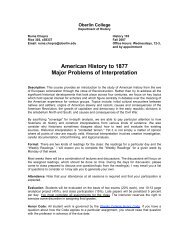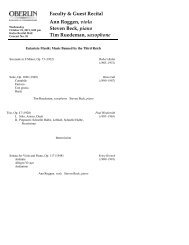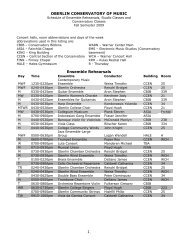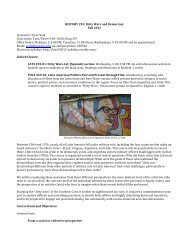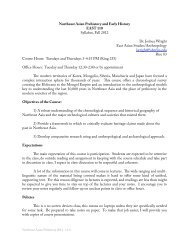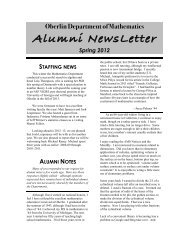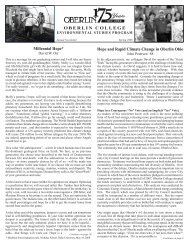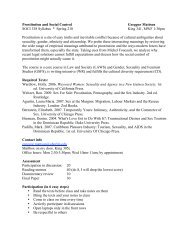Spring 2011 Newsletter - Bad Request
Spring 2011 Newsletter - Bad Request
Spring 2011 Newsletter - Bad Request
Create successful ePaper yourself
Turn your PDF publications into a flip-book with our unique Google optimized e-Paper software.
Oberlin Department of Mathematics<br />
Alumni NewsLetter<br />
<strong>Spring</strong> <strong>2011</strong><br />
JACK CALCUT<br />
We were pleased to welcome Dr. Jack<br />
Calcut to the Mathematics Department this year.<br />
Jack works in the areas of low dimensional<br />
topology, geometric topology, and the topology<br />
of orbit spaces. In addition to teaching<br />
introductory and intermediate level mathematics<br />
courses, Jack taught Geometry at the upper level<br />
this year; next year he will offer 300-level<br />
courses in Topology and in Number Theory.<br />
Jack comes to Oberlin by way of Michigan<br />
State University, where he completed a<br />
postdoctoral position at his alma mater (class of<br />
1999). He earned his Ph.D. at the University of<br />
Maryland in 2004, then took a postdoctoral<br />
position at the University of Texas before<br />
returning to Michigan State in 2008 to work for<br />
two years as part of an active geometry and<br />
topology research group. Jack’s work has<br />
appeared in the The Journal of Algebra and Its<br />
Applications, The Journal of Knot Theory and<br />
Its Ramifications, and The American<br />
Mathematical Monthly, among other venues.<br />
During his postdoctoral appointment at<br />
Michigan State, Jack directed two<br />
undergraduates in research. Thus, it was no<br />
surprise that he was willing to direct an Honors<br />
Student, Madhav Kaushish, on the topic of<br />
Algebraic Number Theory, during his first year<br />
at Oberlin.<br />
Jack’s wife, Margot, teaches mathematics at<br />
Lake Ridge Academy in Elyria. They have two<br />
children.<br />
OLIVER SCHIROKAUER<br />
It is with mixed feelings that we report on<br />
Oliver Schirokauer’s future. After teaching in<br />
the Department of Mathematics for 18 years,<br />
Oliver has resigned from the College in order to<br />
pursue a career as a physician. He is currently<br />
enrolled in medical school at Case Western<br />
Reserve University, where he is part of the way<br />
through the first year of the lengthy and<br />
challenging process of becoming a doctor. We<br />
are confident that he is up to the task and can<br />
handle the rigors of being a medical student, but<br />
we miss his daily presence on the second floor<br />
of the King Building. We wish him the best of<br />
luck; our loss is the medical community’s gain.
Benjamin Jakubowski, Rebecca Uhlman, and<br />
Patrick Haggerty have been working on ternary<br />
sequence sorting algorithms with Elizabeth<br />
Wilmer as their advisor this year. In March, they<br />
presented their results at the <strong>Spring</strong> Meeting of<br />
the Ohio Section of the Mathematics<br />
Association of America, held at Youngstown<br />
State University.<br />
ALUMNI NOTES<br />
(Many of your responded to our request for<br />
alumni notes a few weeks ago. Here are those<br />
responses (lightly edited).)<br />
Age 85, in a retirement home, some<br />
distance from a university library and with no<br />
car. Thank heaven for the Internet! Learn as<br />
much as you can about that personal library at<br />
your disposal on your computer. With Bing you<br />
can even do quite a lot of bibliographic work to<br />
back up your scientific papers. For instance, try<br />
Wikipedia on Fibonacci numbers.<br />
--Margaret (Waugh) Maxfield 47<br />
Joint work by four of us succeeded in<br />
simplifying the proof of a result in number<br />
theory. We published it in 2010 [in Journal of<br />
Number Theory, “Divisibility of Exponentials<br />
Sums via Elementary Methods”]. My coauthors<br />
are from the University of Puerto Rico<br />
(Francis N. Castro and Ivelisse Rubio) and from<br />
Paris Telecom (Hugues Randriam).<br />
--H.F. Mattson '51<br />
My math activities have wound down to<br />
reviewing the occasional item for Computing<br />
Reviews and helping my grandson deal with 6th<br />
grade math. Actually his biggest problem is that<br />
he's being taught much differently from his<br />
parents. They're more anxious than he is.<br />
--Chuck Crawford '60<br />
I am just finishing working with some<br />
mathematicians on progressions describing what<br />
the math Common Core State Standards mean.<br />
The standards are way way better than most<br />
state standards were, and it will be wonderful<br />
not to have 50 different sets of standards (one<br />
for each state).<br />
I have developed some geometry materials<br />
so that young students can experience "the right<br />
angled shapes": rectangles (including square<br />
rectangles), right triangles, and isosceles<br />
triangles made from two congruent right<br />
triangles. The only materials now in use in<br />
PreK and elementary focus on the equilateral<br />
triangle world (shapes made from a small<br />
equilateral triangle). Now I'm working on<br />
materials for the parallelogram and acute/obtuse<br />
triangles made from their diagonals. This is all<br />
fun for me because most of my research has<br />
been on number and computation.<br />
In October I had a great visit and hike in<br />
beautiful snow with Peter Molnar. We used to<br />
study for calculus tests together. Seems like<br />
only moments ago!!!!!!<br />
--Karen Fuson '65<br />
I am taking a term sabbatical from my math<br />
teaching position at George School (Newtown,<br />
PA), during which I will be doing no<br />
mathematics whatsoever; rather I will be putting<br />
together a book of excerpts from 50 years of my<br />
parents' letters (to me) for the wider family. It is<br />
an interesting project, a portrait of my family<br />
and my parents' marriage over half a century. I<br />
will also have time for some music, some<br />
watercolor painting, and the enjoyment the<br />
coming of spring in Bucks County.<br />
--Mary Dart '66<br />
I plan to retire on July 1.<br />
-- Tom Gregory '67<br />
I was installed as President of the Ohio<br />
Council of Teachers of Mathematics at the<br />
OCTM Annual Conference in Akron last<br />
October. In the past year I have presented at the<br />
Greater Akron Mathematics Educators Society<br />
mini-conference (Using Mathematical Tricks<br />
and Games to Teach Algebraic Proof) and at the<br />
National Council of Teachers of Mathematics<br />
2
Annual Conference and Exposition (Teaching<br />
Mathematics Through Music). I am currently<br />
teaching in the Lorain City Schools at the Credit<br />
Recovery Academy, a school for students who<br />
are trying to pick up credits from courses they<br />
did not pass the previous year.<br />
--Mark Jaffee '67<br />
I am moving on...to Elgin, Illinois<br />
(Chicago-area), where my son Chris, his wife<br />
Jeannine, and baby Evelyn (3/10/<strong>2011</strong>) live.<br />
When I made the decision to move, my son Dan<br />
also lived near Chicago, but alas he moved<br />
to Connecticut last fall. (Lest you worry, his<br />
departure was not caused by my impending<br />
arrival, just coincidental.) I still work for Rho,<br />
Inc. as a biostatistician, and I have been based at<br />
home for nearly a year. However I can work<br />
from home there just as well, so off I go. I look<br />
forward to sharing in the life of my<br />
granddaughter, but I'm moving into a new home<br />
in a nearby "active adult" community as a way<br />
to build my own new life in a place that is easy<br />
to make new friends. While there is much about<br />
the Boston area and New England that I will<br />
dearly miss, I am looking forward to the next<br />
step in life when I move in early May.<br />
Professionally, I'm still quite active. I'm<br />
wrapping up a 3-year gig as an officer in the<br />
Biopharmaceutical Section of the American<br />
Statistical Association, which followed a 3-year<br />
tour of duty on the ASA Board of Directors,<br />
which followed... I'm off to client meetings in<br />
NYC and at the FDA before I move, so there is<br />
no moss growing under my feet. However, if<br />
some of you have mastered retirement, I'd love<br />
to have advice--I hear the transition can be hard<br />
and I want to do it gracefully when the time<br />
comes. I'm moving, but my email will stay<br />
kmonti729@gmail.com.<br />
--Kathy (Nuckolls) Monti '71<br />
I continue to teach mathematics at Concord<br />
Academy in Concord, MA. Four years ago I<br />
began using multiple-choice voting questions in<br />
my calculus and precalculus courses, to promote<br />
discourse and conceptual thinking. At first the<br />
students voted by holding up cards. Last year I<br />
introduced clickers, handheld devices to<br />
transmit votes and display the results. (In class<br />
on parents' weekend after the students voted on<br />
this question, "True or false: You were once<br />
exactly pi feet tall," the parents enjoyed their<br />
turn to vote, as well as the ensuing lively<br />
discussion about the intermediate-value<br />
theorem.) Never a dull moment in the math ed<br />
biz!<br />
-- Deborah Gray '72<br />
I am still teaching mathematics at The Taft<br />
School in CT, supervising the Math Team, and<br />
mentoring young teaching fellows right out of<br />
college. I got a little spoiled through last year as<br />
I had a young man who finished second in the<br />
USAMO two years running. He helped our<br />
team score well in the Harvard-MIT<br />
Mathematics tournament also. Now he is a<br />
freshman at Harvard (chose between full rides<br />
there, Yale, MIT, and Cal Tech), and I am back<br />
to more ordinary performers on the team. So it<br />
goes.<br />
--Ted Heavenrich ‘74<br />
Well, I'm not sure if this counts as<br />
interesting, but I am pleased to report that the<br />
Third Edition of my book Data Mining<br />
Techniques has just appeared. It is very much<br />
updated from the second edition.<br />
--Michael Berry '78<br />
I'm still in Geneseo, NY, teaching at a<br />
branch of the State University of New York.<br />
Having spent this past academic year as the<br />
Coordinator of Theatre and Dance (don't ask-academic<br />
politics are the worst politics) I get to<br />
jump from the fire into the frying pan--next year<br />
I'll begin a three-year term as Chair of the<br />
Mathematics Department. I'm still enjoying<br />
teaching a wide range of things, from Logic and<br />
Set Theory to Modeling Biological Systems.<br />
The State of New York is broke, and that means<br />
that the college is dealing with difficult budget<br />
issues. We may be absorbing a few computer<br />
scientists into the mathematics department in the<br />
next couple of years as part of a plan to save<br />
money.<br />
As for family, my eldest daughter, Heather,<br />
is starting the college search while my son, Eric,<br />
is surviving life in middle school (boy, I'm sure<br />
glad I don't have to be a teenager again!) My<br />
wife, Sharon, is having a blast working as a<br />
potter and she spends her spare time driving the<br />
ambulance for the local fire department. We<br />
have two cats and a guinea pig, with lots of<br />
deer, fox, and other wildlife to keep us<br />
company. So life is good, even though I still<br />
miss my Oberlin days--both as a student and as<br />
a faculty member.<br />
--Chris Leary '79<br />
3
I graduated in 1979 and joined the USAF as<br />
an officer. I thank the US taxpayers for fully<br />
paying for my MS in Operations Research,<br />
which I earned at George Washington<br />
University. My interest in OR was a direct result<br />
of taking classes from Prof. Igor Frolow. I even<br />
ran into him one day in the DC metro while in<br />
grad school.<br />
I spent a total of 6 years in the AF as an OR<br />
analyst in the Pentagon mainly working on<br />
budget scenarios involving other countries.<br />
While there, I was mentored by my boss, who<br />
after retiring, moved to Arizona. He recruited<br />
most of his staff, and I joined him at once-great<br />
semiconductor corporation, Motorola. In 1987, I<br />
changed companies, and have worked for<br />
Honeywell Aerospace ever since as an avionics<br />
engineer. Also in 1987, I married Tony<br />
Massimini, an electrical engineer. We have two<br />
children, a 22 yr old daughter and a 21 yr old<br />
son. Neither has an ounce of mathematical or<br />
engineering brain matter. Our daughter<br />
graduated from the University of Arizona last<br />
year, majoring in Italian and History. She<br />
avoided all Math in college--so much for having<br />
positive role models! She's spent a year working<br />
as a hostess at a restaurant, as well as<br />
freelancing as a photographer, and this summer,<br />
begins law school in Sacramento, CA at<br />
University of the Pacific. Our son attends<br />
Northern Arizona University and has recently<br />
switched majors to Accounting.<br />
I totally credit majoring in Math for having<br />
a successful and well-paying career.<br />
--Esther Marx Massimini '79<br />
I am the coauthor of a book entitled<br />
"Statistical Learning for Biomedical Data"<br />
(Cambridge University Press: Practical Guides<br />
to Biostatistics and Epidemiology, <strong>2011</strong>). The<br />
book is for anyone who has biomedical data and<br />
needs to identify variables that predict an<br />
outcome, for two-group outcomes such as tumor<br />
/ not tumor, survival / death, or response from<br />
treatment. Statistical learning machines are<br />
well-suited to these types of prediction<br />
problems, especially if the variables being<br />
studied may not meet the assumptions of<br />
traditional techniques.<br />
-- Karen Malley '80<br />
I am currently Branch Chief and Senior<br />
Investigator in the Biostatistics and<br />
Bioinformatics Branch at the National Institute<br />
of Child Health and Human Development. His<br />
group of ten Ph.D. biostatisticians does<br />
statistical research related to reproductive, child,<br />
and adolescent health. Major research areas are<br />
in developing new methods for longitudinal data<br />
analysis, survival analysis, and the analysis of<br />
genetic and biomarker data.<br />
On another note, my group is in the<br />
intramural part of NIH. As such, we have an<br />
active summer program where students are paid<br />
to spend the summer doing research with us.<br />
It’s too late for this year, but I encourage you to<br />
identify some good Oberlin students who may<br />
be interested in this for next year.<br />
--Paul Albert '81<br />
I joined Sony this year to help start a new<br />
division in healthcare, and promptly found<br />
myself deeply immersed in mathematics.<br />
Imagine the statistics and population<br />
identification that goes on between the shutter<br />
press in a camera and when the smiles are big<br />
"enough" to take the photo. Currently, I am<br />
looking for new technologies and new<br />
businesses.<br />
On a personal level, our miniature belted<br />
Galloway herd continues to thrive here in<br />
California, where they love the snow and rain<br />
that we get in the San Jose foothills.<br />
--Peter David '81<br />
I left my employer of 20 years to work for a<br />
new firm. Mostly to see something different,<br />
and also because the new firm will transfer me<br />
to Beijing in a year. Our (Michael and I)<br />
children are grown. Thomas is going to graduate<br />
school and Andrew is going to college this fall.<br />
So, we are free to move about. Michael has<br />
accepted a teaching post in Beijing, and my new<br />
employer will transfer me there. If you travel to<br />
Beijing, please come to visit us. The best way<br />
to contact us is via e-mail.<br />
--Imelda Yeung Powers '81<br />
I am now Group Leader of the Los Alamos<br />
National Laboratory Statistical Sciences Group.<br />
Founded in 1967, the group partners with<br />
scientists, engineers, and policy makers to solve<br />
problems of national importance by providing<br />
statistical reasoning and rigor to<br />
multidisciplinary scientific investigations and<br />
the development, application, and<br />
communication of cutting-edge statistical<br />
research.<br />
--Joanne Wendelberger '81<br />
4
I am currently Professor of Medicine and<br />
Assistant Dean for Academic Affairs at Thomas<br />
Jefferson University in Philadelphia, PA. My<br />
clinical practice is in hepatology and I keep one<br />
foot firmly planted in the realm of medical<br />
education. I have been married to Gail Herrine<br />
'83 for 25 years. Our two eldest sons both<br />
graduated from Oberlin in 2010 - one a<br />
humanist, the other a scientist.<br />
--Steve Herrine '82<br />
I've released my third CD of original<br />
classical music, "Music Among Friends"<br />
(Centaur Records No. 3077), and am now<br />
putting the finishing touches on a symphonic<br />
tribute to astronomy. And by day, I continue<br />
doing application support and programming for<br />
University of Michigan Medical Center<br />
Information Technology.<br />
--Matthew H. Fields (Double degree<br />
'84/'85)<br />
http://www.matthewfields.net<br />
These are some of the discrete math<br />
questions that I have been looking into recently:<br />
1) conjugate interval orders describing the two<br />
complementary ways to say that one time<br />
interval (for example) is "before" another; 2)<br />
ruminations on the apparent ubiquity of semimodular<br />
functions on ordered structures, for<br />
example as the rank functions of matroids; 3)<br />
the need to extend graph motif analysis methods<br />
to the general case of labeled, directed graphs;<br />
4) how to recover simple concepts like convex<br />
hulls, perimeters, areas, and Hausdorff measures<br />
in discrete metric spaces (that is, metric spaces<br />
where the underlying space is discrete, like a<br />
graph or an ordered set). All of these are quite<br />
important for a range of questions in<br />
information systems management which we care<br />
about here at PNNL, in applications like<br />
ontology clustering and data mining in semantic<br />
graph databases. Get in touch if you're a<br />
colleague or student excited by these topics.<br />
--Cliff Joslyn '85<br />
I am in my fourth year as an Assistant<br />
Professor of Mathematics at Harvey Mudd<br />
College in Claremont, CA. I really enjoy<br />
working with my colleagues and my students.<br />
After teaching at the middle and high school<br />
levels, my job at a small liberal arts college<br />
provides me the new opportunity to combine<br />
teaching and research. I have been studying the<br />
mathematics of a variety of problems in fluid<br />
dynamics, from the dynamics of thin liquid<br />
films with surfactants (chemicals that lower<br />
surface tension), to the surface pattern on the<br />
ocean made by whales, to the coordination of<br />
groups of aquatic robots. I enjoy collaborating<br />
with folks in Math and Physics from UCLA, NC<br />
State University, Duke University and the<br />
University of Washington. I am now teaching<br />
first-year writing in addition to a variety of<br />
mathematics courses, which is not so strange<br />
after completing a Math and English double<br />
major at Oberlin. I never imagined living in<br />
SoCal, since I am firmly a North Carolina gal,<br />
but I love the variety of fruit and vegetables<br />
growing in everyone’s yards and the lack of<br />
bugs that eat them. My family seems to enjoy<br />
the chance to bike all over town all year long<br />
and head to the mountains for snow during most<br />
months. As I write this it is 90 degrees in town<br />
with snow-capped mountains in view!<br />
--Rachel Levy '89<br />
For the past few years I've been developing<br />
audio software. I am 1/3 of Cockos Inc.<br />
Cockos makes REAPER<br />
(http://www.reaper.fm), a digital audio<br />
workstation (which is installed in a lab at the<br />
Oberlin Conservatory), and I also make the<br />
Schwa line of audio effects processors.<br />
Audio DSP is a lively field. The most<br />
mathematically interesting thing I've done lately<br />
was the Olga virtual analog synthesizer<br />
(http://www.stillwellaudio.com/?page_id=37,<br />
please forgive the frothy text on that page). The<br />
challenge was to combine circuitry modeling<br />
with a user-controllable degree of<br />
unpredictability -- far more unpredictability than<br />
would ever be observed in physical circuitry --<br />
without generating digital artifacts or generally<br />
sounding bad. The implementation involved<br />
applying an evolving bezier transformation to a<br />
digitally generated waveform, and then<br />
processing the result through a discrete fourier<br />
transform to forcibly remove aliasing artifacts.<br />
My math studies at Oberlin tended heavily<br />
toward the theoretical rather than the applied, so<br />
interestingly I have not encountered many<br />
situations where I've been able to apply specific<br />
math domain knowledge that I learned at<br />
Oberlin. But what I have been able to apply,<br />
and what in retrospect I think was the most<br />
important part of my math education at Oberlin,<br />
was a general approach to problem-solving that<br />
starts with the assumption that if I apply<br />
*myself* sufficiently to the problem, I will be<br />
5
able to solve it. In other words, there's no such<br />
thing as domain knowledge that is out of reach,<br />
there is only domain knowledge that I don't yet<br />
know.<br />
-- John Schwartz '89<br />
I am now 3/4 of the way through my first<br />
year of teaching high school in Cincinnati, OH.<br />
I teach AP calculus and multivariate calculus<br />
(which is about to turn to other topics) as well as<br />
honors and AP physics. The students are<br />
wonderful and I'm having a lot of fun with the<br />
teaching.<br />
-- Lenore Horner '92<br />
I've taken a tenure-track position in<br />
mathematics at California Lutheran University,<br />
a small liberal arts college not unlike Oberlin in<br />
certain respects. I spend most of my time with<br />
teaching-related tasks; this semester I've been<br />
delighted to teach topology, my research area.<br />
I've still managed to find time to devote to<br />
research-level point-set topology, focusing<br />
mainly on cardinality bounds on homogenous<br />
topological spaces. I presented a paper at a<br />
conference in Greece last summer and will<br />
likely present newer results at the Prague<br />
Topological Symposium this summer. I've also<br />
found time to dabble in my other main math<br />
interest, mathematical models of the spread of<br />
invasive species. Lately I've focused on models<br />
of desert grass exotics, in conjunction with<br />
biologists at the Arizona Sonoran Desert<br />
Museum. In other news, I have a wonderful 15month-old<br />
son who's become an avid<br />
investigator of applied chaos theory around our<br />
house. His chief word at the moment is "no",<br />
which makes conversation, uh, interesting.<br />
--Nathan Carlson '94<br />
I work at the Advanced Visualization Lab at<br />
the National Center for Supercomputing<br />
Applications, a small team which produces datadriven<br />
scientific visualizations, particularly for<br />
public outreach. Last year, we worked on the<br />
scientific visualization scenes for the IMAX<br />
Film "Hubble 3D". In particular, we were<br />
responsible for the flight through the Orion<br />
Nebula, and the journey into the Hubble Ultra<br />
Deep Field. All told, we produced about 10<br />
minutes of the 44 minute film.<br />
This fall I'll be moving to Tucson, where<br />
my wife Paige recently landed a tenure-track<br />
position. We're still negotiating a position for<br />
me, so wish me luck!<br />
--Matt Hall '94<br />
mahall@illinois.edu<br />
http://www.ncsa.illinois.edu/~mahall<br />
I'm currently a lead infosec engineer with<br />
MITRE, working in The Hague, Netherlands.<br />
We've been here for 3 years so far. This past<br />
year was a lot of fun because I became a mom.<br />
I'm expecting another little one at the end of the<br />
year.<br />
--Sarah Brown '00<br />
I completed a Ph.D. in Civil Engineering at<br />
the Georgia Institute of Technology in<br />
December. My dissertation was on<br />
characteristics of public transit network design<br />
and operations that meet multiple sustainability<br />
goals. Next stop is Munich, Germany for a postdoc<br />
on Mobility Culture in Megacities.<br />
--Laurel Paget-Seekins '01<br />
I live with my wife and son in the Boston<br />
area. I currently work as a software developer<br />
and am pursuing a Masters in Software<br />
Engineering from the Harvard Extension<br />
School.<br />
--Jordan Mueller '01<br />
I finished a Masters in Architecture at the<br />
University of Michigan last May. I am excited<br />
to now be working at the Museum of<br />
Mathematics in Manhattan. The Museum is a<br />
start-up project, and not yet open. We plan to<br />
open in 2012, and are on a mission to reveal the<br />
wonders of mathematics to a broad and diverse<br />
audience through highly interactive and<br />
dynamic exhibits. It's going to be a really<br />
exciting place, and I hope to run into many<br />
fellow alums there!<br />
--Emily Vanderpol '02<br />
I am currently finishing a two-year visiting<br />
position as a math professor at Carleton College,<br />
and next fall will be starting a tenure-track job at<br />
UW Eau Claire. In the past two years, I have<br />
been able to attend a Several Complex Variables<br />
conference in Brazil and to be a delegate at the<br />
International Congress of Mathematicians in<br />
Hyderabad, India. This is the conference where<br />
the Fields medals and other prizes are awarded,<br />
and is the biggest mathematical conference in<br />
the world.<br />
6
On a more personal note, I got married last<br />
June and we are expecting our first child in late<br />
July.<br />
--Jon Armel '03<br />
I earned my bachelor's in math in 2004<br />
from Oberlin. I've done a few different things<br />
since then; my career has been moving more in<br />
the direction of science and math lately. Right<br />
now is actually a very exciting time for me and<br />
it seems unlikely my activities over any six<br />
month span in my life will ever be this<br />
impressive again:<br />
This spring I'm finishing a master's in<br />
Atmosphere and Energy in the Civil and<br />
Environmental Engineering department at<br />
Stanford University. Right now I'm working as<br />
a research assistant to Dr. Chris Field of the<br />
Carnegie Institute of Washington on a project to<br />
quantify the exchange of carbon dioxide<br />
between the biosphere and atmosphere. This<br />
summer I'm working as a fellow with the NYC<br />
office of the Natural Resources Defense<br />
Council, modeling the interaction between<br />
climate and agriculture. I will begin PhD<br />
studies in Harvard University's Department of<br />
Organismic and Evolutionary Biology this fall,<br />
doing modeling and field studies of terrestrial<br />
ecosystems and global change.<br />
--Stephen Klosterman '04<br />
My daughter Irene Yunhua Sun was born<br />
on Aug 21, <strong>2011</strong>. She is 7 months old now. So<br />
far she is very talented at sleeping through the<br />
night, which sure has made her working mom<br />
happy and well rested. The math side of<br />
her mom is already wondering when she can<br />
start teaching Irene counting, and<br />
maybe even throwing the 9 dots puzzle at her<br />
some day.<br />
--Ellen Chai '05<br />
I don't have much to report mathematically,<br />
but I am currently a Sales Representative for an<br />
international wine import company T Edward<br />
Wines. I am continuing my education with wine<br />
studies at the Wine & Spirits Education Trust,<br />
and have recently travelled to vineyards in<br />
Napa, Bordeaux, Chile and Argentina. I live in<br />
Williamsburg, Brooklyn, and am in the bridal<br />
party of two Oberlin alumni weddings this year.<br />
--Georgia Blume '06<br />
This is my fifth year of graduate school in<br />
Georgia Tech's ACO program. My research<br />
involves graph theory and the combinatorics of<br />
finite partially ordered sets. I hope to graduate<br />
soon! As for something interesting, I learned<br />
recently that we, as babies, naturally think of<br />
quantities logrithmically. That is, instead of<br />
thinking that 1, 2, 3, and 4 differ by the same<br />
amount, babies think that 1, 2, 4, and 8 differ<br />
equally, and the difference between 7 and 8 is<br />
much smaller than the difference between 1 and<br />
2. In fact, there exist societies that haven't made<br />
this switch --- when asked which number is<br />
half-way between 1 and 9, the adults say 3, not<br />
5.<br />
--Noah Streib '06<br />
I am currently finishing up my Master's in<br />
Music Composition at Illinois State. Next<br />
semester I will be attending the Hartt School of<br />
Music in the Doctoral Music Composition<br />
Program.<br />
I haven't come across too much exciting<br />
Math out here in Music land, but I have<br />
occasionally helped people with homework and<br />
used Math references in some of the classes I<br />
teach.<br />
--Will Huebler '08<br />
Although not particularly math related, I am<br />
finishing up my time as a Shansi Fellow up in<br />
the Himalayas of Himachal Pradesh, India. I<br />
didn't realize how much I had missed a good<br />
problem set until my Hinditutor asked me to<br />
help her study for an upcoming exam and tutor<br />
her in some of the tougher math concepts. I<br />
took a couple of the problems home with me<br />
that she had been having trouble with. Although<br />
they were all straight-forward trigonometry and<br />
algebra problems, I tore through them with a<br />
thirst like a traveler in the desert. I had<br />
forgotten how much fun systems of equations<br />
are!<br />
--Jenna Lindeke '09<br />
COMMENCEMENT<br />
• This year our Commencement Reception<br />
is Sunday, May 29 from 2-4 PM in King 205. If<br />
you're here for commencement, please come;<br />
we would love to see you.<br />
7


